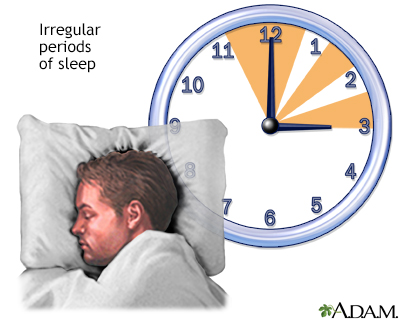Sleep disorders - overview
Insomnia; Narcolepsy; Hypersomnia; Daytime sleepiness; Sleep rhythm; Sleep disruptive behaviors; Jet lag
Sleep disorders are problems with sleeping. These include trouble falling or staying asleep, falling asleep at the wrong times, too much sleep, and abnormal behaviors during sleep.

Symptoms of sleep-wake syndrome include irregular periods of sleep and wakefulness which disrupt the normal daily sleep-wake cycle. It may be caused by brain dysfunction or not following a normal sleep schedule, ultimately leading to a pattern of insomnia and frequent daytime napping.

Sleep patterns change with age, anxiety levels and many other factors. Normally, younger people have more concentrated periods of deep sleep compared to older people.

Do you have trouble falling asleep at night? Or, do you go to sleep, only to wake up a few hours later and stay awake for hours at night? Well, let's today talk about insomnia. Your sleep-wake cycle is a delicate pattern run by something called circadian rhythms. These rhythms are physical, mental, and behavioral changes in your brain that roughly follow a 24-hour cycle. Your daily and nightly habits, many you learned as a child, may affect your circadian rhythms and how well you sleep at night. Poor sleep or lifestyle habits that may cause insomnia include going to bed at different times each night, daytime napping, and a poor sleeping environment such as too much noise or light. Spending too much in time in bed while you're awake can change your sleep patterns too. Likewise, working evenings or night shifts and not getting enough exercise can affect your sleep. People who use alcohol or recreational drugs may have trouble sleeping. Heavy smoking and drinking too much caffeine can also cause insomnia. And, even using some types of sleep medications a lot can cause you to lose sleep. Medical problems can cause insomnia too. People with anxiety disorders, bipolar disorder, thyroid disease, depression, and chronic pain problems may have trouble going to sleep or staying asleep. So, what do you do about insomnia? Well, it's important to remember that not everyone needs 8 hours of sleep every night. Some people do just fine on 6 hours of sleep, while others need much more. If you need more sleep, your doctor will probably ask about any medications you're taking, your drug or alcohol use, and your medical history. Spend some time thinking about your lifestyle and sleep habits. It's best to avoid caffeine and alcohol at night. If you don't exercise, starting regular exercise might help you sleep better. If you're depressed or anxious, talk to your doctor to see if relaxation techniques can help, if medication might be helpful, or if seeing a mental health provider is best. If you're suffering from bouts of insomnia, take heart. Most people can return to more normal sleep patterns when they make simple changes in their lifestyle or habits.
Causes
There are more than 100 different sleeping and waking disorders. They can be grouped into four main categories:
- Problems falling or staying asleep (insomnia)
- Problems staying awake (excessive daytime sleepiness)
- Problems sticking to a regular sleep schedule (sleep rhythm problem)
- Unusual behaviors during sleep (sleep-disruptive behaviors)
PROBLEMS FALLING AND STAYING ASLEEP
Insomnia includes trouble falling asleep or staying asleep. Episodes may come and go, last up to 3 weeks (be short-term), or be long-lasting (chronic).
PROBLEMS STAYING AWAKE
Hypersomnia is a condition in which people have excessive daytime sleepiness. This means they feel tired during the day and are prone to falling asleep. Hypersomnia can also include situations in which a person needs to sleep a lot. This may be due to other medical conditions, but can also be due to a problem in the brain. Causes of this problem include:
- Medical conditions, such as fibromyalgia and low thyroid function
- Medicines that are sedating
- Mononucleosis or other viral illnesses
- Narcolepsy and other sleep disorders
- Obesity, especially if it causes obstructive sleep apnea
When no cause for the sleepiness can be found, it is called idiopathic hypersomnia.
PROBLEMS STICKING TO A REGULAR SLEEP SCHEDULE
Problems may also occur when you do not stick to a regular sleep and wake schedule. This occurs when people travel between time zones. It can also occur with shift workers who are on changing schedules, especially nighttime workers.
Disorders that involve a disrupted sleep schedule include:
- Irregular sleep-wake syndrome
- Jet lag syndrome
- Shift work sleep disorder
- Delayed sleep phase, as in teenagers who go to sleep very late at night and then sleep until noon
- Advanced sleep phase, as in older adults who go to sleep early in the evening and wake up very early
SLEEP-DISRUPTIVE BEHAVIORS
Abnormal behaviors during sleep are called parasomnias. They are fairly common in children and include:
- Sleep terrors
- Sleepwalking
- REM sleep-behavior disorder (a person moves during REM sleep and may act out dreams)
References
Avidan AY. Sleep and its disorders. In: Jankovic J, Mazziotta JC, Pomeroy SL, Newman NJ, eds. Bradley and Daroff's Neurology in Clinical Practice. 8th ed. Philadelphia, PA: Elsevier; 2022:chap 101.
Sateia MJ, Thorpy MJ. Classification of sleep disorders. In: Kryger M, Roth T, Goldstein CA, Dement WC, eds. Principles and Practice of Sleep Medicine. 7th ed. Philadelphia, PA: Elsevier; 2022:chap 69.
Version Info
Last reviewed on: 4/20/2023
Reviewed by: Allen J. Blaivas, DO, Division of Pulmonary, Critical Care, and Sleep Medicine, VA New Jersey Health Care System, Clinical Assistant Professor, Rutgers New Jersey Medical School, East Orange, NJ. Review provided by VeriMed Healthcare Network. Internal review and update on 02/12/2024 by David C. Dugdale, MD, Medical Director, Brenda Conaway, Editorial Director, and the A.D.A.M. Editorial team.
